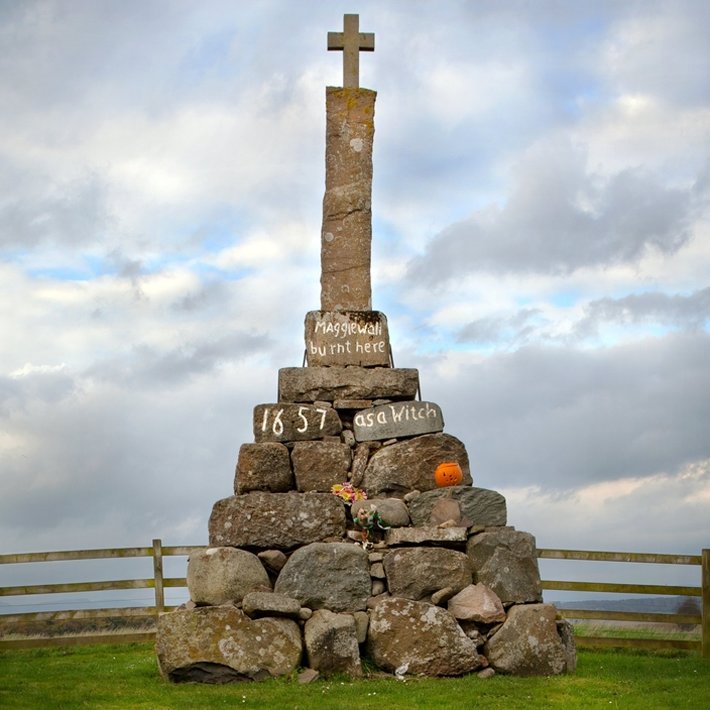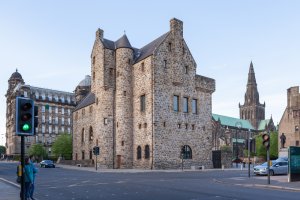Thou shalt not suffer a witch to live – Exodus 22:18
The ancient land of Scotland harbors many secrets, and stories worthy of a chill on All Hallows Eve. But in Old Town Edinburgh in a centuries-old building of stone, mortar and memory, the cobwebs have been swept away and long-hidden truths are surfacing.

Scotland’s new Museum of Magic, Fortune-telling and Witchcraft, which opened earlier this year in a 17th-century stone structure just off of Royal Mile in the old town, affords visitors a glimpse at amulets and charms and other mystical treasures used by witches ages ago.
“Scotland has had a long history of magic and witchcraft, which goes way beyond Harry Potter. I wanted to highlight this magical heritage,” says Ash William Mills, the museum’s founder and historian of Scottish witchcraft and magic.
But there was more to Mr. Mills than a fascination with the dark arts. The museum’s presence is a reminder to Scots of a buried chapter in their history. The Witchcraft Act, passed in 1563, opened the door to the torture, false imprisonment and abuse of innocent men and women on the charge of witchcraft.
Witchcraft hysteria was already peaking in Europe, sparked by a treatise written 77 years earlier by two German monks on how to detect and stamp out witchcraft. For centuries ordinary people had practiced forms of witchcraft in their own homes, mixing potions, casting spells and performing rituals for all manner of things—love, curing illness, banishing bad luck. If one’s crops rotted or one’s milk soured the day after an argument with a neighbor, the logical conclusion was that your neighbor had cursed you. Generally the “curse” would be lifted through communication, agreements and repairing the relationship.
But the Witchcraft Act changed all that. “This is when the idea came along that the witches had sold their souls to the devil, were dancing and having sex with him. People believed that the devil was real and working black magic,” said Claire Mitchell, co-host of the “Witches of Scotland” podcast.
Over four-fifths of those accused of witchcraft were women, many unmarried or widowed and therefore with neither protection nor rights. “It was a terrible miscarriage of justice, and because there has not been enough emphasis on women’s history, it is forgotten. Battles and wars fought by men got recorded but not this,” said Mitchell.
It was a simple matter to get the accused to confess. Torture—often in public—by thumbscrews, iron collars, sleep deprivation and a scold’s bridle—an iron muzzle which pressed down on the tongue and caused excruciating pain and prevented speech or food intake—was the prescribed method. “They were asked leading questions while being tortured and made to confess about their pact with the devil,” said Mitchell, who along with podcast writer Zoe Venditozzi founded an advocacy group that is working toward a pardon and a memorial for the witches.
All told, in a country of about one million, nearly 4,000 people were accused of witchcraft, with 2,500 executed until the Act was finally repealed nearly two centuries after its beginning.
Scotland’s witch hunt frenzy can be traced to royalty. In 1590, a storm hitting the ship bearing home King James VI of Scotland and his new bride from Copenhagen very nearly killed the king and his queen.
Persuaded that the tempest was brewed by witches, he set on a witch hunt, resulting in the trying and torture of nearly 70 innocents, some burned at the stake.
On display at the museum is a pamphlet, “Newes from Scotland,” describing the events, and a book authored by the king seven years later on how to spot and prosecute witches for the crime of “high treason against God.” Chapters in the book begin, “I am ordained King by God, and therefore I am speaker of God Himself.”
Museum founder Mills says, “My main aim was to bring awareness to the persecution of innocent men and women. I wanted to show how the paranoia and panic spread.”
The opening of the Museum of Magic, Fortune-telling and Witchcraft was well-timed. Some months earlier, Scotland’s then first minister, Nicola Sturgeon, acknowledged the “egregious historic injustice” by extending a “formal posthumous apology to all of those accused, convicted, vilified or executed under the Witchcraft Act of 1563.” Two months later, the Church of Scotland did the same.
As Margaret Malloch, University of Stirling professor and head of learning resources at the group, Remembering the Accused Witches of Scotland, says, “Even now, there are groups and individuals with no power who are marginalized and scapegoated. There are many parallels between justice and injustice historically and contemporarily. It is why we cannot forget this history.”
Blog contributed by Gladys McBride
_______________
From its beginnings, the Church of Scientology has recognized that freedom of religion is a fundamental human right. In a world where conflicts are often traceable to intolerance of others’ religious beliefs and practices, the Church has, for more than 50 years, made the preservation of religious liberty an overriding concern.
The Church publishes this blog to help create a better understanding of the freedom of religion and belief and provide news on religious freedom and issues affecting this freedom around the world.
The Founder of the Scientology religion is L. Ron Hubbard and Mr. David Miscavige is the religion’s ecclesiastical leader.
For more information, visit the Scientology website or Scientology Network.


